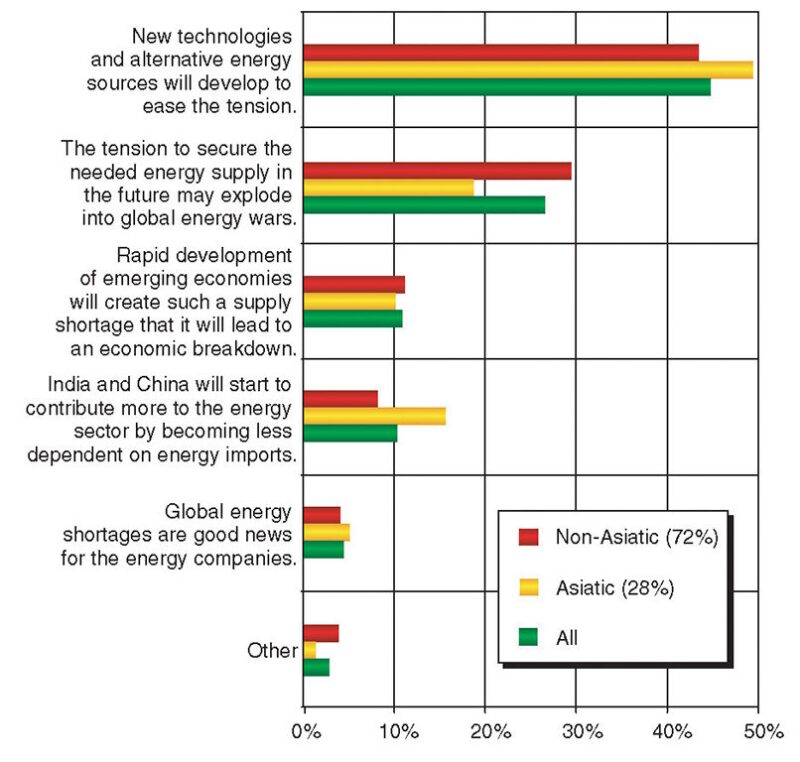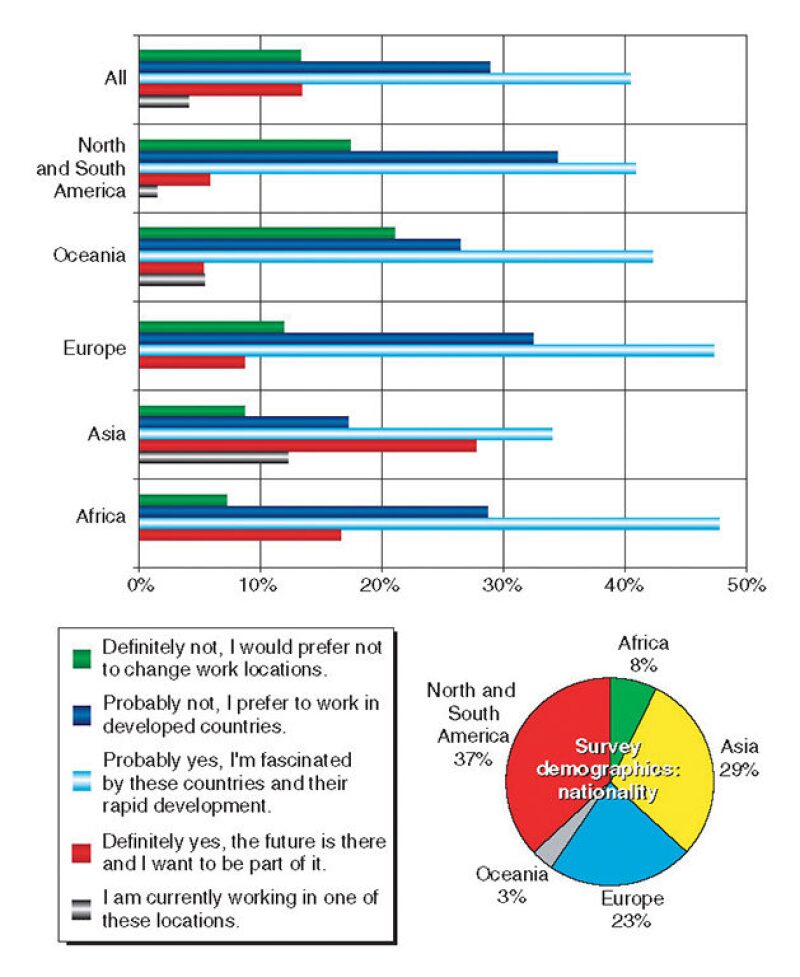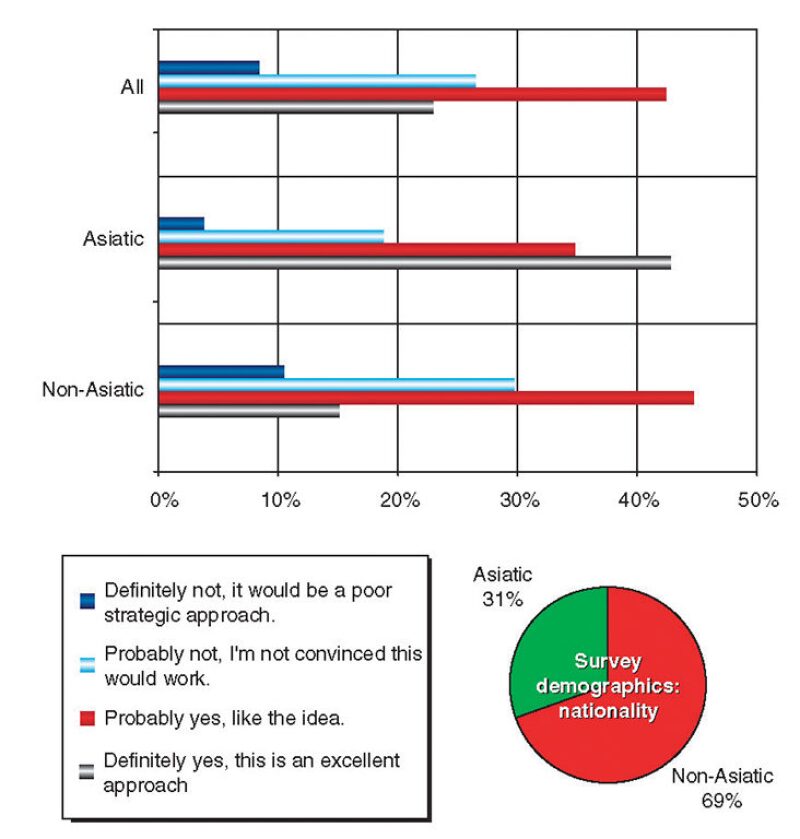Home to nearly two-fifths of humanity, two neighboring countries, India and China, are two of the world’s fastest-growing economies. Their impact is enormous on several aspects of our present and future. India and China offer significant opportunities and threats to the oil and gas industry and the world economy in general; furthermore, their boom poses important questions about the delicate themes of energy demand and job market.
Loris Tealdi and Rita Onyige, TWA Forum Editors
Our latest survey had 562 respondents. The nationalities of roughly two-thirds of respondents were from Asiatic countries, while 37% were from North and South America. Concerning the primary work location, North and South America represented the largest population (41%), while 15% of respondents work in Asia. The male/female mix was 87/13. More than half of the respondents were between 25 and 30 years old.
China and India: Economic Opportunities and Threats
What factors contribute most to boosting China’s and India’s economies?
Most respondents (36%) associate the boost in China’s and India’s economies with their availability of cheap labor. This is by far the most recognized competitive advantage, regardless of the nationality, work location, age, or gender of the respondents. The second-biggest factor saw a split among respondents. Asian respondents identified political attitudes and mentality, while non-Asian respondents gave more weight to attitude toward work. Though less than 6% of non-Asian respondents believe the unique skills and education in China and India contribute to the boost in their economies, this factor seems to be the third-most popular choice of Asians.

China and India appear to be on a path toward strong and sustainable growth. What, if anything, might knock them off this path?
Twenty-one percent of the 1,181 respondents are of the opinion that an energy shortage could knock China and India off their path of strong and sustainable growth. This is representative of all the respondents independent of their primary work location, except for those working in the Middle East. They see political instability as the most dangerous factor. Other important factors across all the respondents are corruption and safety.

Emerging countries consume more than half of the world’s energy and have accounted for 80% of the growth in oil demand over the past 5 years. We work in the energy business and in the future may have to face the problem of global energy shortages. Which of the following statements is most correct?
A significant percentage (45%) believes that new technologies and alternative energy sources will develop to ease tension, indicating a strong optimism in the future. On the opposite side, another 26% believe that the tension to secure the needed energy supply in the future may explode into global energy wars. Rapid development of emerging economies will create such a supply shortage that it will lead to an economic breakdown; some believe that India and China will start to contribute more to the energy sector by becoming less dependent on energy imports.

China and India: Opportunity and Threats for the People
Would China or India be on your preferred list of future work locations?
According to 40% of the respondents, the answer was, “Probably yes, I’m fascinated by these countries and their rapid development.” Another 13% chose, “Definitely yes, the future is there and I want to be part of it,” while 4% said that they already worked in one of these locations. A total of 29% answered, “Probably not, I prefer to work in developed countries,” and 13% said, “Definitely not, I would prefer not to change work locations.” Asians and Africans represent the nationalities more willing to work in India and China, Americans less so.
By gender, women seem to be more eager than men to work in India and China. They also seem to have more defined ideas: The percentage of females selecting the answers with “probably” is smaller than for males.

The oil and gas sector needs young professionals to solve problems created by the “big crew change.” Do you think that the problem of the aging workforce within our industry can be solved by attracting and developing Chinese and Indian young professionals (YPs) in the Western companies?
To this question, 42% answered, “Probably yes, I like the idea,” and another 26% said, “Definitely yes, this is an excellent approach.” The remainder indicated that they were not convinced that this would work or that it would be a poor strategic approach. Almost 80% of Asians answered positively, indicating the will and enthusiasm of these countries.
Some selected answers are reported below.
Favorable:
- “If Western companies want to be part of China’s or India’s industry, they will have to adapt to these cultures, and the best way to do so is by attracting and developing YPs from the countries where they want to settle and giving them (YPs) the opportunities to grow with the company and making them feel part of it!”
- “My opinion is that as a recruiter, I believe quality of manpower should be the primary driving factor rather than ‘cheap’ manpower—especially as the upstream sector is not particularly manpower-intensive. In that sense, India and China are able to offer good-quality manpower, and the fact that it comes cheap is an added attraction.”
- “I was the recruiter for my service company in China during 2002–2004 and from the quality of people I met, I have strong confidence that they will soon be able to play a big role in the well diverse international oil and gas market. The change of quality of candidates over those short 2 years was impressive, especially the communications skill and English language ability. But most impressive is their attitude toward the job opportunity offered to them.”
Not favorable:
- “I don’t see an issue with importing some skilled workers from China and India; however, I would have thought that (a) the federal government would limit/control this heavily and (b) do India and China have enough workers to send offshore (and are they skilled?). I am all for any nationality to work freely in any country that demands their skills (i.e., free and elastic supply and demand labor markets).”
- “Although we currently have a shortage of people in the oil and gas sector, flooding the market with YPs is not the answer, no matter what country they come from. To do so is to return to the boom and bust mentality from which the industry is currently trying to escape. Gradual expansion of the YP workforce is the most sustainable way of filling the gap. If this gradual expansion is supplied from India and China, then so be it.”
- “The problem is that local people do not take up the reins. There are universities and colleges full of talented young engineers and graduates of all disciplines who could easily succeed in the oil industry. The problem is attracting them into our industry. The pay is good, but the image and locations are perceived to be substandard. We need to raise the profile of energy companies at the school gates. Make it like the financial industry and somewhat more glamorous.”
- “I’ve worked in both India and China. Of course we will be able to source some of the young professionals from those countries, but we need to get them out of those countries and working for Western companies for them to develop the work ethic. Both have very intelligent people.”

The oil and gas industry has the potential to access a large number of university-educated young professionals in emerging markets. How can our industry best attract these individuals?
Some of the responses coming from emerging countries follow.
- “Communication is the key. YPs visiting universities should explain the opportunities in this sector and the fascinating daily jobs we are doing. Very necessary to get rid of common thinking of ‘dirty industry’ and reshape the reputation of our industry.”
- “Convince them of the industry’s sustainability and show them the technological challenges we are facing. The oil industry needs to renew its image of working conditions.”
- “There are lots of talents in the developing/underdeveloped countries that are wasting away. There can be a grassroots approach by going to the secondary and high schools to encourage young ones to focus on oil and gas courses and the reasons for it. Scholarship opportunity also should be provided. The university environment is another place to catch them young. The companies should encourage emerging graduates to submit their curriculum vitae or resume before graduation, and they should be encouraged by jobs.”
- “The petroleum industry already stands as one of the best-paid industries in the world. That alone gives the industry a huge advantage over other hip industries such as marketing, IT and banking. However, lack of publicity might be the reason why the industry could not attract the best of young minds. Perhaps it is time for the industry to step out of its hide and reveal itself to the public.”
- “The recipe is easy. Differently from developed countries, in the emerging ones, money is still the major attraction factor since people study and then make sacrifices also to pay back the investments of their family. Go to secondary schools and university and show that in the oil industry, making good money is easy!”

Conclusions
The theme of this issue generated a lot of discussion and diverging opinions. China and India represent a radical change in the worldwide economy and offer at the same time opportunities and threats, questions and answers, solutions to known problems, and unexpected scenarios. The large majority of survey respondents see the Dragon and the Tiger as partners with which alliances should be established for worldwide synergetic growth. The qualities most appreciated of these countries are the availability of cheap labor and the attitude toward work. Indian and Chinese YPs may represent, therefore, the solution to the pressing problem of the big crew change, even if not all think this may be the best option. According to many, the E&P industry should first try to modify its image and attract the numerous local YPs who have not yet decided to join the energy sector, a sector that will become increasingly crucial in the future and that soon will need to find solutions to the scarcity of energy on the planet, a scarcity to which China and India contribute. Given the increasing importance of the delicate theme of energy for both the E&P industry and the global economy, the next forum will focus on that subject.

